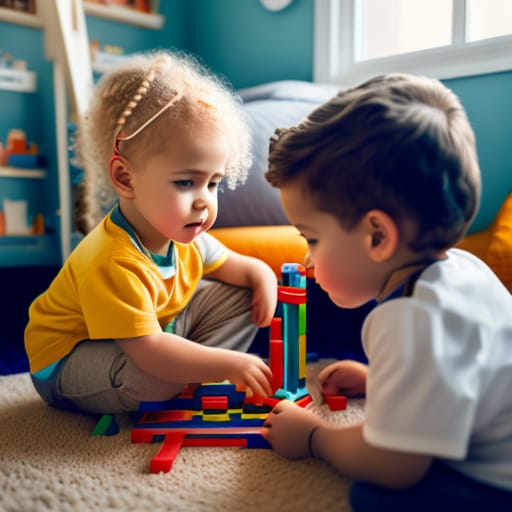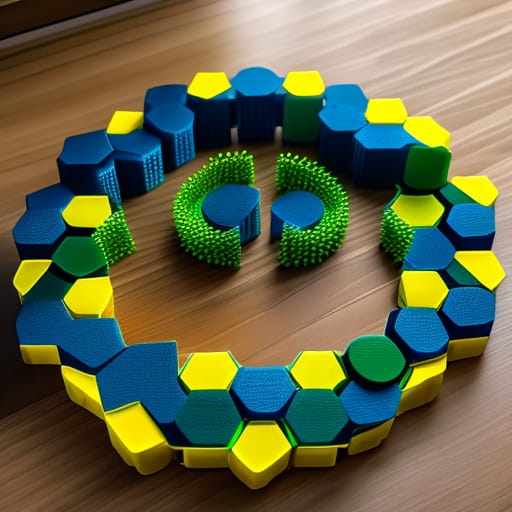Building toys provide immense benefits for a 5-year-old’s development and growth. As children approach this pivotal age, parents seek ways to stimulate their cognitive, social-emotional, motor, and educational progress through play. This guide will explore the many advantages of building toys while reviewing top picks to consider.
Why Building Toys Matter at Age 5
Around age 5, a child’s brain undergoes substantial change. Building toys help nurture development by:
- Enhancing fine motor control
- Promoting visual-spatial and problem-solving skills
- Fostering creativity and imagination
- Developing social-emotional learning
- Teaching educational concepts like STEM, math and language
- Improving concentration and attention to detail
Unlike toys with restrictive uses, building sets allow for open-ended play. This flexibility encourages innovation and discovery-based learning. Construction play also supports growth across multiple domains from cognitive to physical to social-emotional.
As kids edge towards more structured schedules with kindergarten approaching, building sets provide a self-directed creative outlet to balance screen time. Parents can feel good about the inherent learning taking place during this independent yet engaging process.
Types of Building Toys for 5-Year-Olds
From classic LEGOs to magnet tiles and beyond, many building toys exist to stoke a 5-year-old’s curiosity. First, let’s examine popular styles:
Brick Building Sets
Timeless LEGO sets remain favorites for aspiring young builders. With themes from castles to trains to cities, brick kits spur storytelling and role play. LEGO’s “Builders of Tomorrow” line offers age-appropriate challenge levels to match fine motor skills. The vibrant colors and textures captivate senses as kids construct 3D models piece-by-piece.
Straw and Connector Sets
For more budget-friendly, eco-conscious options, look at building kits using straws or cardboard connectors. Sets like Roylco’s Straws and Connectors encourage experimentation across STEM disciplines. The open-ended play promotes critical thinking as children problem-solve to build increasingly complex structures.
Magnetic Tile Sets
Magnetic building tiles, like PicassoTiles, allow for limitless three-dimensional creations. Kids explore spatial reasoning, geometry, and polarity through manipulating the colorful magnets. Compared to bricks, tiles have more flexibility for inventing designs not shown on instructions. Tiles also easily stick together and pull apart – perfect for little hands.
Key Developmental Benefits of Building Toys
Building toys deliver a wealth of developmental upsides at age 5 across motor, cognitive, social, and educational domains.
Enhancing Motor Skills
Around age 5, children display immense progress in fine motor dexterity. Building play promotes hand-eye coordination, grip strength, and precision. Following step-by-step models calls for controlled finger and wrist movements. Open-ended construction also allows practice grasping and manipulating pieces. These activities assist improving motor planning and execution.
As children gain competence, they feel motivated to attempt more complex creations, further advancing abilities. LEGO’s DOTS line, for instance, features small, colorful pieces to challenge motor growth.
Boosting Cognitive Abilities
Beyond building physical skills, construction toys exercise minds. Following pictorial instructions requires focused visual-spatial processing as kids envision the end product. This visualization aptitude connects to early math concepts like shape recognition.
The trial-and-error puzzle-solving of building also flexes executive functioning skills. Children demonstrate concentration, planning, and critical thinking to modify approaches. When a tower topples, testing new architectural solutions teaches resilient problem-solving. Open-ended play expands perspective-taking as kids incorporate peers’ ideas.
Dr. Susan Bartell, psychologist, explains construction toys present opportunities to practice cognitive flexibility, sequencing, and critical thinking from an early age. These competencies will aid children as they tackle new intellectual hurdles in elementary school.
Fostering Creativity and Imagination
Construction inspires invention by sparking the intrinsic desire to create. Unlike coloring books or puzzles with defined outcomes, building sets empower kids to manifest imaginative worlds. A box of LEGOs may transform into a magical castle or a straw set could become a futuristic rocket ship. This process promotes ingenuity, narrative generation, and role play.
Child development researcher Dr. Sandra Stone indicates open-ended toys cultivate resourcefulness, curiosity, and problem-solving – ingredients for creativity. Building is associated with artistic hobbies later in life like engineering, design, and architecture.
Promoting Socio-Emotional Growth
Collaborative building activities teach relationship skills and emotion management. Compromising on shared visions for block structures helps children overcome frustration and challenges them to see alternate perspectives.
Accomplishing goals through teamwork builds confidence while peer bonding occurs cooperatively. Constructive feedback between partners occurs organically during the engineering process. Managing collaborative efforts additionally strengthens communication, leadership and conflict resolution abilities.
Building Educational STEM and Academic Concepts
Beyond social skills, building toys reinforce educational concepts in the sciences, math, engineering and technology. Following visual guides to recreate structures uses geometry, spatial reasoning and sequencing principles. Weighing stability of materials and testing load-bearing builds basic physics hypotheses. Grouping pieces by color or size practices categorization and sorting math abilities.
Constructing vehicles with LEGO motors utilizes engineering and design competencies. Using kits to form letters or numbers reinforces early literacy. The interdisciplinary, inquiry-based learning of building play parallels approaches prioritized in kindergarten.
Rodney Rodriguez, toy inventor and cognitive scientist, recommends building toys to cultivate STEM thinking through experimental hands-on activities. Children witness cause-and-effect relationships first-hand by iterating models.

Top Picks: Best Building Toys for 5-Year-Olds
With an endless array of building toys available, deciding where to start can feel overwhelming. To narrow options, here are five top-rated construction playsets promising hours of enriching fun for 5-year-olds.
1. LEGO Classic Bricks Bricks Bricks Set
- 1100+ pieces including windows, wheels, mini people figures and bricks in 33 colors
- Promotes open-ended building creativity
- Pieces sorted into storage container with lid
- Age: 4+ years
- Price: $59.99
This LEGO bucket overflows with possibilities. With no step-by-step instructions, kids freely construct anything imaginable from the boldly colored bricks. Mini figurines, eyes, wheels and other specialized pieces add storytelling fun. Sorting trays keep tidy.
2. PicassoTiles 100 Piece Magnet Building Tiles Set
- 100 magnet tiles in 10 colors, 6 shapes to spark 3D designs
- Fosters spatial, geometry and polarity science concepts
- Magnets click together easily – no connectors needed
- Age: 3+ years
- Price: $39.95
These transparent magnet tiles encourage little engineers to defy gravity building structures that twist and turn. The chunky pieces easily stick together from all angles to form intricate scaffolded towers or symmetrical patterns. Vivid colors captivate while sparking imagination.
3. Strawbees 200 Piece STEM Building Set
- 200 straw pieces featuring flexible joints, wheels and eyes
- Connectors allow linking straws at various angles
- Promotes skills in construction, mechanics and design
- Pieces made from plant-based renewable sugarcane
- Age: 5+ years
- Price: $24.99
This innovative straw and connector kit made sustainably from sugarcane plants invites open-ended engineering projects from race cars to dinosaurs and beyond! Bendable joints enable multi-dimensional movement. Great for travel or environments where noise or messes are concerns.
4. Magna-Tiles Clear Colors 100 Piece Set
- Includes 3” and 5” transparent tiles in triangle, square and right triangles
- Smooth tile edges prevent scratched floors or hands
- Guide offers model ideas organized by theme
- Case for tidy storage and travel
- Age: 3+ years
- Price: $124.99
These crystal-clear magnetic tiles encourage experimenting to form sculptures, buildings, animals or conveyances only limited by imagination. The durable plastic stands up to heavy use while the transparent quality adds dimension and light play. Grants for schools available.
5. Roylco Straws and Connectors Building Kit
- 305 pieces including straws, eyes, people and animal figures
- Flexible connectors allow multi-angle designs
- Recycled paper straws – eco-friendly toy
- Great for travel – easily packs flat
- Age: 5+ years
- Price: $15.95
With almost 300 pieces, this affordable kit offers tremendous open-ended construction possibilities from designing three-story dollhouses to weaving straw sculptures. Young engineers develop spatial reasoning competencies while boosting creativity. Connectors tightly grip straws without requiring tape or glue.
Maximizing the Power of Building Play
While building sets present innate developmental benefits, parents can further nurture their child’s growth through engagement. Try these tips:
Allow Open-Ended Exploration
Rather than recreating kits piece-by-piece, emphasize inventing unique constructions. Praise imaginative additions like incorporating beloved action figures or craft supplies into builds.
Ask Open-Ended Questions
Pose questions sparking thinking: Why do you think that part connects there? What would happen if you added wheels? How will you ensure your tower is balanced? Such prompts motivate persistence and critical reasoning without prescribing solutions.
Encourage Collaborative Building
Suggest working together on a shared vision or combining your separate models into an integrated city with distinct responsibilities. Coordinate supplies, listen to each other’s viewpoints, compromise on ideas and manage frustrations.
Display All Creations
Treat every masterpiece as gallery-worthy! Rotating constructions provides a sense of pride. Capturing images to compile building portfolios also reinforces the creative process’ significance.
Through active participation paired with praise and encouragement of effort over outcomes, parents can exponentially expand building play’s positive influence.

Final Thoughts
As 5-year-olds stand on the brink of kindergarten, building toys deliver immense value. Construction play’s benefits span promoting fine motor dexterity, visual-spatial reasoning, problem-solving, mathematics, science concepts and social-emotional learning. Perhaps most importantly, building inspires creativity and curiosity – ingredients for innovation.
While navigating the multitude of building toys filling store shelves, focus on choosing developmentally appropriate options tailored your child’s distinct interests. Allow plenty of open-ended construction time while offering encouragement. Soon, you may have the next engineer or architect in your midst erected impressive structures right in your living room!
Frequently Asked Questions
Are building toys appropriate for both girls and boys?
Absolutely! Building toys provide universal developmental upsides for all children regardless of gender. Open-ended construction kits intentionally allow kids to follow their unique interests rather than conforming to limiting stereotypes. Building uniquely intersects STEM and art by blending engineering, design and creativity.
What safety issues should I consider with building toys?
While major manufacturers emphasize child safety, carefully examine construction kits for potential choking hazards from small toy parts or sharp edges. Closely supervise play until you feel confident in abilities to monitor age limits and hazards. Consider your child’s dexterity and mouthiness. For extra reassurance, opt for larger sized building pieces like LEGO DUPLO blocks or chunky magnetic tiles.
Should I purchase building toy add-ons like motors or lights?
As children demonstrate responsibility caring for basic building toy sets, advance the challenge by introducing add-ons like motors to power moving vehicles, lights to illuminate structures or kits to foster specific interests like architecture or coding. Guide play to ensure safe use of any electrical components requiring batteries. Consider needs and developmental stage before purchasing addons.
How can I choose building toys on a budget?
If investing in higher-end building brands like LEGO seems temporarily unfeasible, employ creativity sourcing more affordable options. Discount retailers or second-hand stores often sell kits at reduced prices. Eco-friendly kits made from straws, sticks or cardboard make great starter sets for years of use. And don’t underestimate supplies around the home – from empty cardboard boxes and toilet paper tubes to index cards and aluminum foil, kids can construct almost anything.
What are the best building toys to develop STEM skills?
Construction kits like LEGO Education WeDo robotics, Magformers XL Magnetic Building Sets, or Strawbees Vicky’s STEM Laboratory use engineering-inspired challenges to cultivate early science, technology, engineering and math proficiencies. Following step-by-steps to assemble robots with working motors or designing ultra strong geomagnetic structures teaches real-world problem-solving, spatial reasoning and design technology concepts hands-on.
